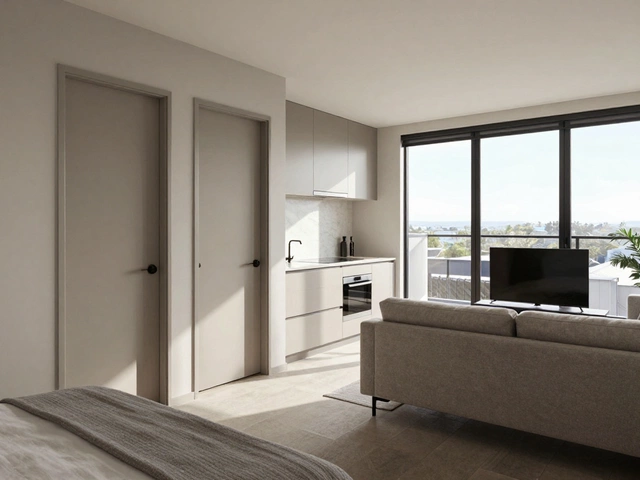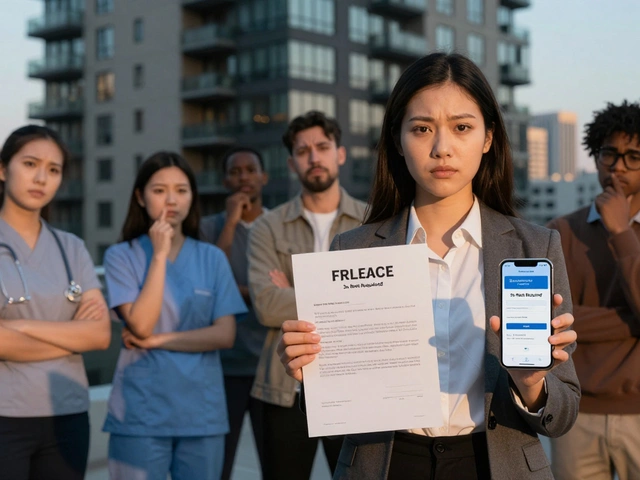Landlord Agreement: What It Really Means for Renters and Owners

If you’ve ever wondered what a landlord agreement actually does, you’re not alone. Most people only skim it, kind of like the terms and conditions for a new app. Big mistake. This deal is packed with rules on rent, repairs, security deposits, and what happens when someone breaks the deal. Miss something important, and you could be on the hook for way more than you expected.
At its core, a landlord agreement is just a written contract between a property owner and a tenant. It spells everything out—how much rent you pay, who fixes what, what you’re allowed to do inside the place, and how you get your deposit back. No handshake deals or “we’ll figure it out later”—if it’s not in writing, it usually doesn’t count. Landlords use it to keep the property safe and cash flowing. Tenants rely on it to avoid getting kicked out or being hit with surprise fees.
Believe it or not, some states make the rules super strict about what needs to be inside this agreement. Stuff like the exact address, rent dates, and even who pays for the water bill. Leaving things vague can lead to heated arguments—and sometimes, ugly court visits. That’s why you want this document crystal clear, with no confusing legal speak or hidden loopholes.
- Landlord Agreement: The Basics
- What’s Usually Inside
- Key Rights and Duties for Both Sides
- Red Flags and Deal Breakers
- Negotiating for Better Terms
- Quick Tips Before You Sign
Landlord Agreement: The Basics
In simple terms, a landlord agreement is the main paperwork behind every rental. If you’re renting or letting out, this is the contract that sets all the ground rules. In fact, without one, both the landlord and the tenant are just guessing what to expect and what’s even legal. Whether it’s called a rental agreement, lease, or tenancy agreement, it always answers the same big questions: how much is the rent, when do you pay it, and what’s expected from everyone involved?
Every state in the US has its own rules for these agreements, but there are some basics almost everywhere. Here’s what you’ll usually find packed inside:
- landlord agreement basics like property address and names of everyone involved
- the exact rent amount, due date, and payment method (Venmo, bank transfer, check, etc.)
- the length of the rental (year-long, month-to-month, or something else)
- security deposit details—how much, when you get it back, reasons it could be held
- who pays for which utilities—think water, heat, trash, internet
- rules about pets, smoking, or making changes to the property
- how repairs and maintenance are handled
Skipping any of these can turn simple issues into big headaches. For example, 26% of landlord-tenant disputes in 2023 were about missing or unclear rules in rental agreements, according to the American Apartment Owners Association. That’s huge.
Check out how common some of these basics are in US rental agreements from last year:
| Clause | Included in Agreements (%) |
|---|---|
| Rent Payment Terms | 99% |
| Security Deposit Rules | 92% |
| Maintenance Responsibilities | 87% |
| Utility Payment Breakdown | 79% |
| Pet and Smoking Policies | 69% |
If something feels fuzzy or missing from your agreement, don’t just shrug it off. If it’s not clear or isn’t covered at all, there’s a good chance someone will get burned later on. Bottom line: read the agreement, ask questions, and don’t sign just because you want to get the keys.
What’s Usually Inside
Ever tried reading a rental agreement and felt instantly lost? You’re definitely not alone. Most landlord agreements follow the same basic blueprint, but don’t assume they all look the same. There are a few things you’ll see almost every time—if any are missing, that’s a problem.
- Names and Address: Both the landlord and tenant names, plus the exact address of the property (not just “Main Street”—we’re talking apartment or unit numbers, too).
- Rent Details: The monthly amount, due date, how you pay (bank, cash, app), and sometimes what happens if you pay late. Pro tip: Late fees have to be spelled out, not just “at landlord’s discretion.”
- Security Deposit: How much you pay upfront to cover potential damages, what it covers, where it’s held, and most important—how you get it back. In the U.S., most states demand you get your deposit back within 14–30 days after moving out, unless there’s real damage.
- Lease Term: The start and end date. Month-to-month? Year-long? If there’s an automatic renewal, that needs to be written down.
- Rules on Repairs: Who fixes what? Small stuff like light bulbs or giant stuff like leaking roofs—these need to be clear so you don’t end up covering something you shouldn’t.
- House Rules: Pets, smoking, parking, visitors—these extras can catch you off guard. Always check this section, since going against these rules can end your lease fast.
- Exit Terms: How much notice you or your landlord have to give before ending the agreement, and what happens if you move out early.
| State | Average Deposit ($) |
|---|---|
| California | 2,280 |
| Texas | 1,250 |
| New York | 2,100 |
| Florida | 1,200 |
| Ohio | 995 |
Watch out for any “extra” fees tucked into the fine print. For example, some agreements sneak in charges for parking spots, shared laundry, or even “administrative” fees. If you spot something weird, ask for an explanation or get it in writing. Always double-check that every part matches what you discussed—never just trust a verbal promise.
Key Rights and Duties for Both Sides
A landlord agreement doesn't only spell out what tenants owe in rent. It lays out what both tenants and landlords can expect, demand, and must do. If you gloss over these rights and duties, you can overlook stuff that'll drive you crazy later—like who actually has to handle a leaky roof or a busted furnace in the dead of winter.
For tenants, the big rights include:
- A safe, secure, and clean place to live. Local laws often require landlords to repair broken locks, heating, and basic utilities—no negotiation here.
- Reasonable privacy. Landlords can’t just walk in whenever they want. Most states require 24 to 48 hours’ notice, except in emergencies.
- The right to get their deposit back—minus actual damages—within a set time after moving out (usually 30 days).
- Basic repairs done in a timely way, especially with plumbing and electricity.
On the landlord’s end, they’re entitled to:
- Timely rent payments. Late fees can kick in after a grace period—sometimes just five days—so missing this deadline can cost real money.
- Property upkeep by the tenant. That means no extra holes in walls, no wrecking furniture, and keeping the place somewhat clean.
- Access after giving proper notice, usually to show the place to future tenants or do repairs.
- Getting the place back in basically the same shape as when the tenant moved in, minus normal wear and tear.
Here's a quick table to show who handles what most of the time:
| Responsibility | Landlord | Tenant |
|---|---|---|
| Major repairs (plumbing, roof, heat) | ✔ | |
| Minor repairs (changing bulbs, batteries in smoke alarms) | ✔ | |
| Yard maintenance (unless stated otherwise) | ✔ | |
| Pest control | ✔ (if not caused by tenant) | ✔ (if caused by tenant behavior) |
| Paying rent | ✔ | |
| Fixing tenant-caused damage | ✔ |
One interesting fact: Around 70% of disputes between landlords and tenants are about repairs and deposits, according to data from the American Apartment Owners Association. This is why having these rights and duties spelled out in the landlord agreement isn’t just a formality—it’s your main protection if things go sideways.

Red Flags and Deal Breakers
Some landlord agreements look harmless but are loaded with gotchas. If you want to avoid future drama, you need to know what should trigger your alarm bells before you sign. Here’s what deserves extra attention.
Landlord agreement terms that mess with your rights—like the owner walking in without notice or weird rules about guests—are a massive warning sign. In most states, landlords have to give at least 24 hours’ notice before showing up, and tenant privacy is legally protected. If this is missing, you could lose your peace and privacy at any time.
- No clear repair policy: If the contract doesn’t spell out who handles repairs—or gives the landlord all the power over what gets fixed—you might end up freezing or sweating while waiting forever for a fix.
- Unlimited late fees: Some agreements sneak in crazy fees if your rent is late, even just by a day. Statistically, most states set a cap (usually 5%-10% of your rent). If the fee is open-ended, it’s a trap.
- Security deposit confusion: Watch for vague language about why or how much can be taken out of your deposit. State laws say exactly what can and can’t be deducted. If the agreement doesn’t match, ask for changes.
- Eviction language that’s too easy: If you spot a line that allows the landlord to evict you “for any reason,” that’s not just unfair, it’s often illegal. It needs to follow what your state says about valid reasons.
- Punishing guests or subletting: Some places ban all overnight guests or leave big fines if your parents visit. Overly harsh? You should be able to have visitors as long as you’re not running a hotel.
Check out these facts about rental disputes and problem clauses in the U.S.:
| Issue | % of Disputes Reported |
|---|---|
| Security Deposit Deductions | 27% |
| Repair Responsibilities | 18% |
| Unauthorized Entry | 15% |
| Unreasonable Fees | 14% |
| Sudden Evictions | 11% |
Before you sign, ask direct questions if anything seems weird. Get things corrected in writing. Never rely on promises that aren’t in the lease. If the landlord gets annoyed about you asking, that alone is a red flag.
Negotiating for Better Terms
Most people see a landlord agreement as set in stone, but honestly, there’s a lot more wiggle room than you think. Landlords expect a bit of back-and-forth, so don’t just sign whatever’s handed to you. If something feels off or unfair, call it out before you hand over your cash.
Let’s get practical. Before you say yes to a deal, arm yourself with the going rent rates in your area. In 2024, Rent.com’s report showed about 67% of renters who negotiated on price actually got some sort of discount or rental concession. Know what other buildings are charging, and don’t be afraid to mention it if you find something better in the neighborhood.
- Repairs and Maintenance: Want a faster response time if the heater goes out? Ask for specifics: "Any repairs? Fixed within 48 hours or rent is discounted." Landlords sometimes agree to this because it keeps tenants happy and paying.
- Pets or Special Clauses: Have a pet or need something unusual, like a grill on the porch? Spell it out now. You can push for a pet clause with clear, fair rules instead of a flat-out ban.
- Security Deposit Terms: Want your deposit back in full and on time? Some tenants ask for it to be returned within 14 days of moving out—spelled out in the agreement, not just on a handshake.
- Early Move-Out: Life happens. Landlords might agree to a reasonable early termination fee (often one month’s rent) instead of a penalty that wipes out your savings.
Here’s a quick glance at typical negotiable points and success rates, based on a late-2024 U.S. housing survey:
| What’s Negotiated | How Often Succeed? |
|---|---|
| Rent Price | 35% |
| Repair Times | 25% |
| Pet Clauses | 18% |
| Deposit Terms | 22% |
| Early Termination | 14% |
If you’re not sure how to kick things off, just ask: "Is this the best you can do?" or "Could we tweak this clause to work better for us both?" Most landlords would rather negotiate than lose a good tenant. Get everything in writing—no vague promises or side deals. Once everyone’s signed, you’re locked in, so make sure it works for you first.
Quick Tips Before You Sign
This is the “don’t skip this” part. Before you grab a pen or hit accept on any landlord agreement, you want to make sure you’re not signing something that will haunt you later. Even savvy renters can miss out on the details that cost them way more in the long run.
- Read every line. Sounds obvious, but nearly 40% of renters rush or skim. If anything’s unclear, ask for it in plain English or email for proof. Don’t feel rushed—this is your security, not just paperwork for the landlord.
- Double-check the rent and all fees. Look for late payment penalties, pet charges, parking, and even trash pickup fees. Some landlords will list optional charges in fine print, hoping you miss them.
- Confirm repair responsibilities. Who handles a broken heater or leaky faucet? Some agreements stick tenants with basic maintenance costs, while others make landlords fix everything. Make sure that’s clear up front.
- Inspect move-in and move-out terms. What counts as “damage?” Is ordinary wear and tear explained? Ask for a walk-through checklist. 73% of deposit deductions are tied to disagreements about move-out conditions.
- Know how you can break the agreement. Life changes. Does the lease let you sublet? What’s the penalty for early exit? If it’s missing, you could get stuck or lose your deposit for leaving early.
- Document everything. Snap move-in photos and keep all written communication. Emails about repair requests or special agreements can save you if there’s ever a dispute. In court, screenshots win over “he said, she said.”
To make it even simpler, here’s a quick table on what to check and why it matters:
| What to Check | Why It Matters |
|---|---|
| Rent amount & due date | Avoid late fees and confusion about what you owe |
| Deposits & refund process | Get your money back faster, know deduction reasons |
| Maintenance rules | Stops blame games over repairs and damages |
| Guest & pet policies | Don’t risk unexpected fines or eviction |
| Rules on breaking agreement | Saves you from big penalties if you need to move |
Taking a few extra minutes with your agreement can literally save you thousands—not to mention sleepless nights. Don’t be afraid to negotiate or walk away if something feels off. There are always other rentals, but you only get one signature on this contract.





